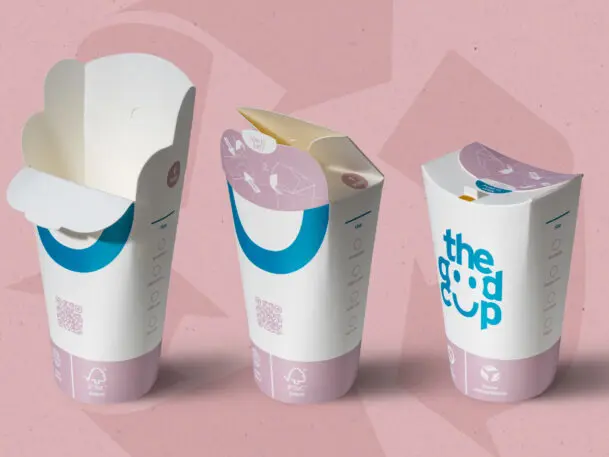Plastic coffee cup lids have been ubiquitous for decades. But as some countries begin to phase out single-use plastic, a new to-go cup design eliminates the need for a separate lid: The recyclable, compostable paper cup folds on top of itself to prevent spills.
Called the Good Cup, the patented cup took years to get right. “It took me about three years and about 1,000 handmade samples to really tweak the paper and the folding,” says designer Cyril Drouet, cofounder of the Hong Kong-based sustainable packaging startup ChoosePlanetA.

Drouet, an experienced packaging designer, uses a reusable coffee mug in his own life. But he also realized that disposable coffee cups are unlikely to disappear anytime soon, and started working on the challenge of improving them in his spare time. (By one estimate, half a trillion disposable coffee cups, and likely nearly as many lids, are thrown out each year.)
The resulting design—which looks a little bit like a miniature takeout box—has flaps that lock together, with an audible click, to form a slightly curved top. The curved shape helps hold the top securely in place, so it won’t accidentally pop open; to open it back up to add cream or sugar to your drink, you have to deliberately push on the top of the lid to release the lock.

It takes a little time to learn to use, though Drouet says baristas typically become comfortable with it within a day. In Japan, the cups recently launched at Family Mart, a chain of convenience stores where customers pour their own coffee. There, the designers are still adjusting the instructions to ensure that no one gets confused (for example, adding fingerprint marks to show where you need to push for each step). The team also continues to tweak the design of the cup itself.

Most paper cups are coated with a plastic lining, but the Good Cup uses a bio-based version called BioPBS that’s certified as biodegradable in home compost bins. The cup has also been certified as recyclable, and if local recycling facilities accept it, Drouet says that’s the best option. “We really wanted to maximize the end of life, because paper can be recycled up to seven times,” he says. “So, in our opinion, it doesn’t make sense to have a cup going to compost when it can be recycled.”
Starbucks tested a different paper cup with the same coating as part of its NextGen Cup Challenge, but hasn’t yet shared results. Drouet says the coating makes the cups easier to recycle than typical paper cups. (Technically, though, other cups are already recyclable and recyclers often just don’t want to accept them; it’s not clear yet how much the new version will change that.)
The biodegradable coating does make the cups more expensive than the standard option. The design saves on shipping costs because the cups can be packed flat, and without lids, more can be packed in a single box. Still, it’s not enough to make up the difference. “It’s almost impossible to compete with plastic, one of the cheapest materials in the world,” Drouet says. “But what is helping us is that if you look around the world, there are now a lot of regulations from governments.”

In France, for example, disposable coffee cups are now banned unless they’re compostable. Western Australia has a similar ban on plastic-lined cups and plastic lids. A new single-use plastic ban in Quebec includes lids. (Other governments are pushing consumers more directly to reusable mugs, like Ireland, which now charges a fee for any type of disposable cup, compostable or not.) For cafes that are now being forced to buy an alternative, the Good Cup is as much as 50% cheaper than other compostable options available now, like lids made from molded paper, says Drouet.
The startup is in talks with larger retailers about the product. “Their strategy is really to see how we are doing, how the market is responding,” he says. “I think once we have adoption from small and medium businesses, that’s when corporations will make a move.” With its current manufacturing partner, there’s capacity to make three billion cups a year, and the company also plans to license the design to local manufacturers, so the cups don’t have to be shipped long distances. It will launch in North America later this year, beginning in Canada.
Recognize your brand’s excellence by applying to this year’s Brands That Matter Awards before the final deadline, June 7.
Sign up for Brands That Matter notifications here.